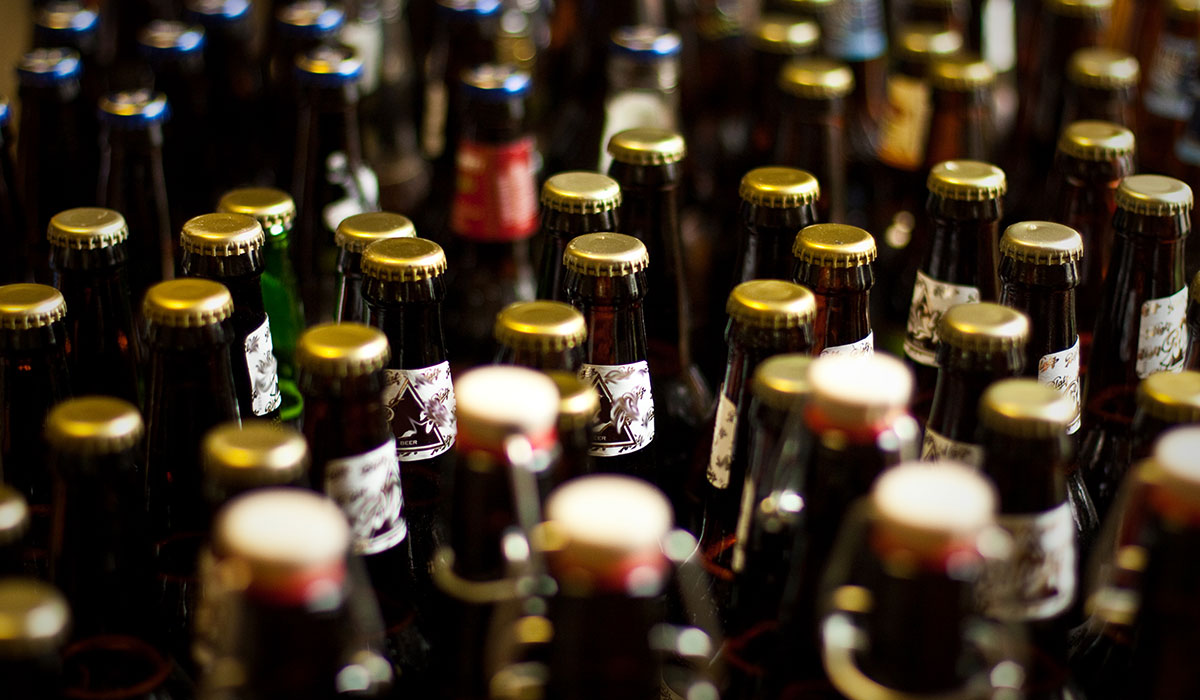Few actions elicit a more impassioned retort in the upper echelons of craft beer geekdom than cellaring beer bottles horizontally on their sides.
Why? I have no idea. If I were to post a picture of the most amazing selection of whales you could dream up, expertly tended to in a temperature, humidity and light controlled cellar; exquisitely cataloged to the Dewey-decimal point (somehow) on their side with a caption reading “FREE,” what would be the first comment on the article? I would bet you a beer that the comment would admonish the orientation of the bottles and proclaim that the beers pictured would be wrought with flavors deemed unacceptable for an aged beer.

I don’t buy it.
Are you placing your special beers for aging in peril by storing them horizontally? I’d like to go out on a limb and say you are not. Admittedly, I do not have empirical data to back this up, but that is due in part to the lack of any study that I, or any of my colleagues, could identify.
(MORE: 5 Beer Stats You Should Know)
Perhaps this is the reason the subject is so hotly debated. The belief that a beer can’t age successfully on its side comes from bits and pieces of beer folklore that have spread as craft beer dogmas. It is these commonly held beer beliefs that serve to bolster a snob mentality, which undermines the freedom we have to enjoy beer how we choose and discourages well-intentioned, uninitiated beer drinkers from starting their own beer journey.
Given that I cannot furnish empirically supported evidence that bottle orientation results in the success or failure of aging beer, I can only offer you a more practical understanding of the practice. While this is not the only dogma in craft beer, taking the time to think through the problem might encourage all beer drinkers, especially in this era of fake news and self-identified “experts,” to question even the most widely held ideas in craft beer.
Origins of Orientation
Once upon a time, there was a practical reason for laying bottles down. Prior to the crown bottle cap, a cork stopper had a tendency to dry out and crumble. It was, therefore, common to try to keep the cork stopper in contact with the enclosed liquid so the cork might avoid shrinking. This is why wine, even to this day, is stored on racks horizontally. (Side note: I wonder why cork dorks don’t get all up in arms about how wine bottles are stored? Probably because they’re more embarrassed they spent so much on that god-awful wine bottle tree at Crate & Barrel – but I digress).
(MORE: 10 Craft Beer Festivals in 2017)
Still, my light-hearted ribbing of oenophiles’ obsession with wine-themed knickknacks might explain the strong push by beer enthusiasts who have railed against the wine-ification of craft beer. I, for one, am glad that we need little more than a glass and a keychain bottle opener to enjoy craft beer, rather than all of the baubles that inhabit the housewares aisles at big box stores.
Seals and Whales
A technological advancement to corks was the crown seal, invented in 1892 by Crown Seal Company. This is the bottle cap that sits atop the vast majority of beer bottles throughout the world. The cap is lined with a plastic seal to act as a gasket between the metal crown and the lip of the glass bottle. Today, some caps even have seals that act as oxygen scavengers to absorb oxygen molecules that reside in the headspace in addition to providing a strong seal.
This could make a case that bottles should not be laid horizontally, due to inhibiting the seal’s effectiveness. However, there is also a concern about seals drying out, like corks, and allowing oxygen to leak in and carbonation to escape. This is particularly true when crowns are pushed to their limit from extended aging of rare beers.
Conditioned Conditioning
The explosion in interest of home cellaring is a salient example of craft beer fans failing to appreciate fully the purpose and processes involved when aging beer. Articles on the subject have conditioned hobbyists to believe that if you have an amazing beer, you should hide it for some time, then the beer will be better than when you first had it. Basically, the longer you wait on the beer, the better it will be. Not quite.
What we fail to appreciate is that brewers release their beers when they are ready to be consumed. True, there are exceptions to every rule, but the payoff extolled of aging beers is indeed exaggerated. Collectors need to be far more selective of the beer they choose to cellar than one might believe, and it isn’t enough to simply follow the guidelines of the types of beers that can be aged, but to understand the potential outcomes of the aging process.
(MORE: 7 Tips to Host a Bottle Share Like a Pro)
Getting Heady About Headspace
One granular point of cellaring beer that has been explained is oxygen’s effect on beer in a bottle — and with good reason. Oxygen resides in the headspace of beer bottles and works to oxidize the beer.
This is the crux of the comment highlighted above. The idea being that if a beer is aged on its side, more of the beer will be exposed to the oxygen resulting in a very specific, expectable result — flavors of sherry and cardboard.
The problem with this thinking, I believe, is threefold: First, it is the beer itself that yields these flavors, not the bottle orientation. In the case of the commenter’s assertion that, “those bottles are all going to be … cardboard bombs from laying them down, I offer the one bit of actual science that can be backed up from Melissa Antone of Cara Technology Limited, makers of Aroxa Flavor Kits. She tells me, “We refer to this compound as ‘papery,’ and the compound is Trans-2-Nonenal (T2N). T2N is released over time and at warmer temperatures. Oxygen in package really isn’t a factor when it comes to this papery flavor, much to many peoples’ surprise!”
Thus, the orientation of the packaging has zero effect on whether the cardboard flavor, known as Trans-2-Nonenal (T2N) occurs in beer.
The second is that if you are being selective about cellaring the right beers, these horizontally cellared beers would often have live yeast as a secondary bottle conditioning. It is the viable yeast in the bottle that act as oxygen scavengers as they work to consume the priming sugar. This will result in the creation of carbon dioxide. CO2 is heavier than oxygen, which means it would act as a blanket barrier between the beer and the oxygen.
(MORE: Estimated Blood Alcohol Content Calculator)
Finally, if one believes that a horizontally oriented bottle poses a detrimental effect on aging beer, wouldn’t the compaction of the yeast into the smaller area in the bottom of a vertical bottle and focused pressure of the liquid on top of the yeast have negative effects on viable yeast, too?
“The beer will age more on its side due to surface area and the decrease in downward pressure on the organisms,” Crooked Stave Founder Chad Yakobson tells CraftBeer.com. “I’m not fussed about storing on their side versus up and down.”
Crooked Stave recently invested in bottle conditioning. The beer will be conditioned on their side in a “custom bottle conditioning cellar like something out of a champagne house or like you see at Cantillon,” Yakobson explains.
Big Picture
I age beers both horizontally and vertically. “Why?” you ask. Mainly due to space constraints, and also because it doesn’t matter. Some beer bottles can fit in a small refrigerator horizontally, which gives me the luxury of keeping these beers at a set temperature. The others line the wall of my crawl space. I have never noticed any substantial difference between beers aged at different orientations.
I try to see the big picture of aging and want you to realize that other variables are far more important to control than orientation, which includes light, temperature and agitation. Think of all the beer fans that trade beers across the country. There is a reason why that hazy IPA that was sent to you in Arizona from Vermont did not wow you; it bounced around in a box for a couple thousand miles. The point is, you can only attempt to get a positive outcome from controlling these variables, but it would be foolish to think that we have any control whatsoever on what’s in the bottle; a beer’s potential has already been decided by the brewer.
Craft beer fans are a passionate bunch. And that passion has helped to drive the popularity of craft beer worldwide. But as advanced of a beer culture we are, there will always be more to learn. It is that lack of complete understanding, combined with the passion and exuberance for beer from small and independent brewers which can present pitfalls to introducing craft beer to the uninitiated. The vast information available online can cause some beer drinkers to accept what others have said without proper critique. In turn, this creates built-in blind spots and knee-jerk confidence resulting in sometimes forgetting to ask questions or apathetic acceptance of myths or commonly held beliefs. Challenging widely held beliefs is healthy in general, but particularly so in today’s craft beer.
CraftBeer.com is fully dedicated to small and independent U.S. breweries. We are published by the Brewers Association, the not-for-profit trade group dedicated to promoting and protecting America’s small and independent craft brewers. Stories and opinions shared on CraftBeer.com do not imply endorsement by or positions taken by the Brewers Association or its members.


Share Post